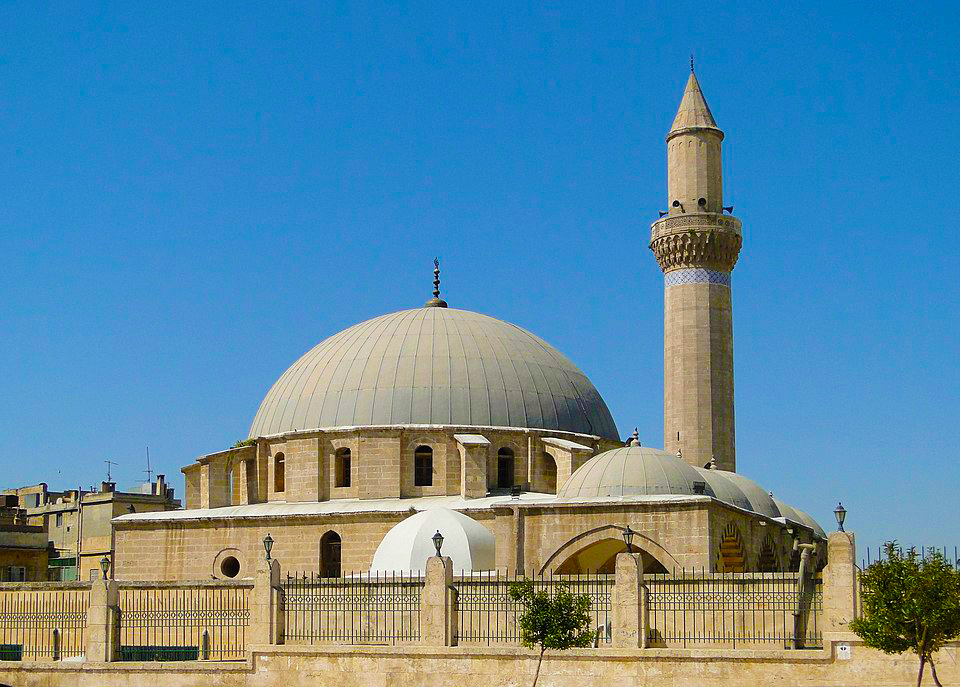Aleppo Historical Mosques: Few cities in the world can rival Aleppo in the depth and diversity of its Islamic architecture. From the heart of the old city to its lesser-known quarters, Aleppo Historical Mosques are not merely places of worship but powerful symbols of art, scholarship, resilience, and continuity. Each of these remarkable structures reflects a distinct era, dynasty, and style, providing travelers and historians with a unique lens into the city’s soul.
This guide takes you through a journey of Aleppo Historical Mosques, highlighting both famous and hidden gems, and focuses on those that best exemplify the religious and architectural heritage of the city. By exploring Aleppo Historical Mosques, visitors can truly appreciate Aleppo’s rich history and spiritual significance
Aleppo Historical Mosques | Summary Chart
| Mosque Name | Era & Year | Key Notes |
|---|---|---|
| Al-Bahramiyeh Mosque (جامع البهرمية) | Ottoman – 16th century (c. 1583) | Built by Bahram Pasha; Ottoman architecture with ablaq stone decoration |
| Al-Othamaniyeh Mosque (جامع العثمانية) | Ottoman – 1730 | Built by Othman Pasha; part of a complex with sabil and madrasa |
| Al-Aadiliyeh Mosque (جامع العادلية) | Ottoman – 1556 | Founded by Darwish Pasha; classic Ottoman dome, elegant design |
| Al-Fardous Mosque (جامع الفردوس) | Ayyubid – 1236 | Built by al-Zahir Ghazi; rich interior, major religious center |
| Al-Rumi Mosque (جامع الرومي) | Ottoman – 16th century | Modest mosque with Ottoman dome and intimate atmosphere |
| Al-Atroush Mosque (جامع الأطروش) | Mamluk – 1398 | Famous for muqarnas portal and ablaq style; Sufi roots |
| Al-Sultaniyeh Mosque (جامع السلطانية) | Ayyubid – Early 13th century | Near the Citadel; mosque-madrasa complex with tombs |
| Al-Qiqan Mosque (جامع القيقان) | Ottoman – 18th century | Modest local mosque; square minaret, serves neighborhood worshippers |
| Al-Tuashi Mosque (جامع الطواشي) | Ottoman – 18th century | Built by merchant Tuashi; simple dome and arches near old souqs |
| Al-Shayabiyeh Mosque (جامع الشعيبية) | Umayyad origins – Rebuilt later | One of Aleppo’s oldest; small mosque near Citadel with early Islamic layout |
| Al-Safahiyeh Mosque (جامع السفاحية) | Mamluk – 14th–15th century | Small neighborhood mosque; known for dome and local historical value |
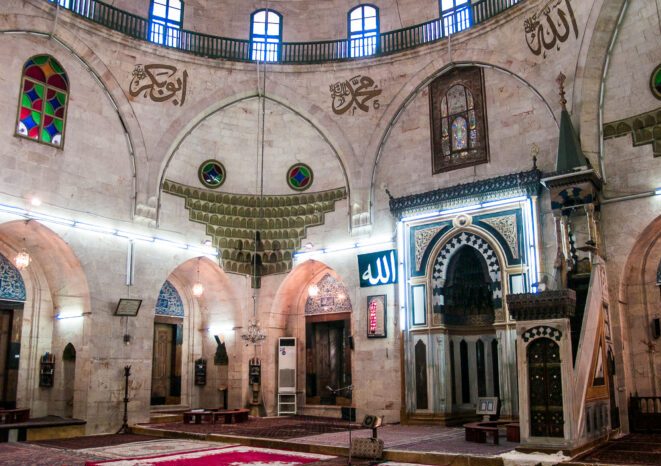

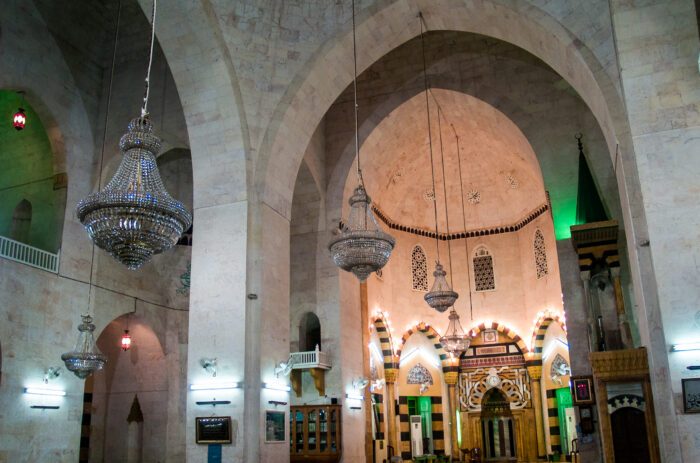

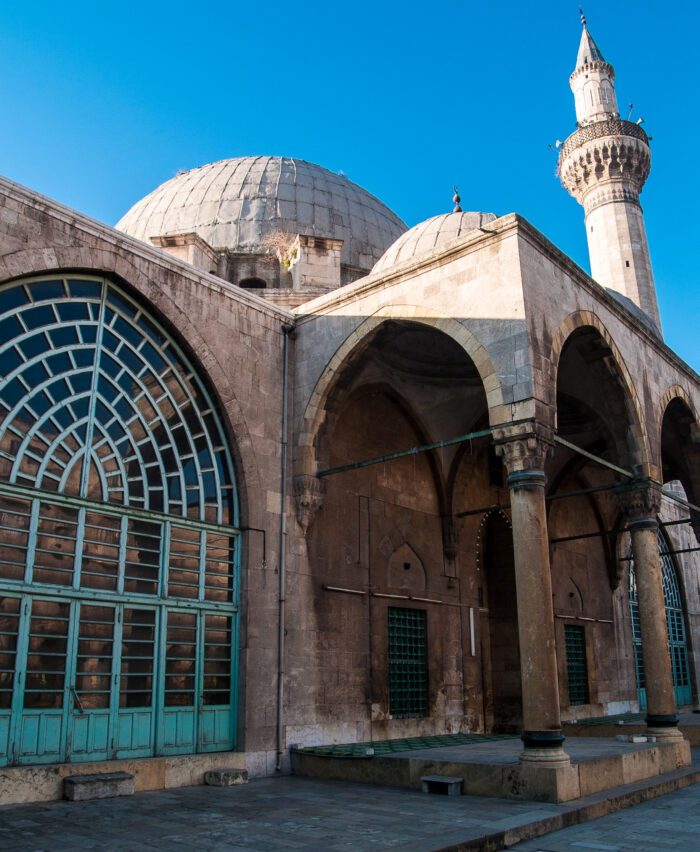

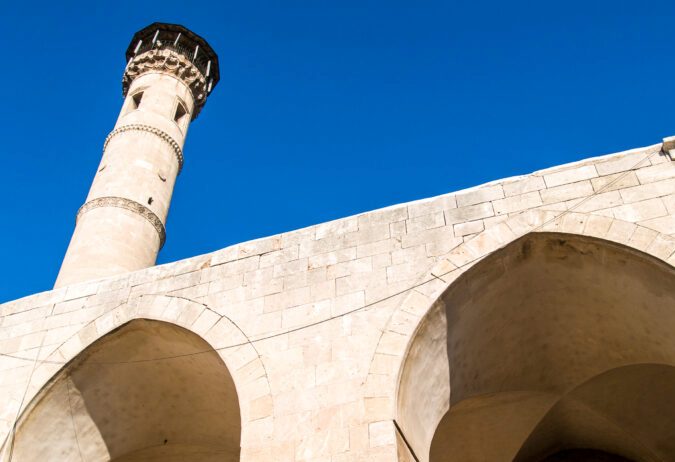

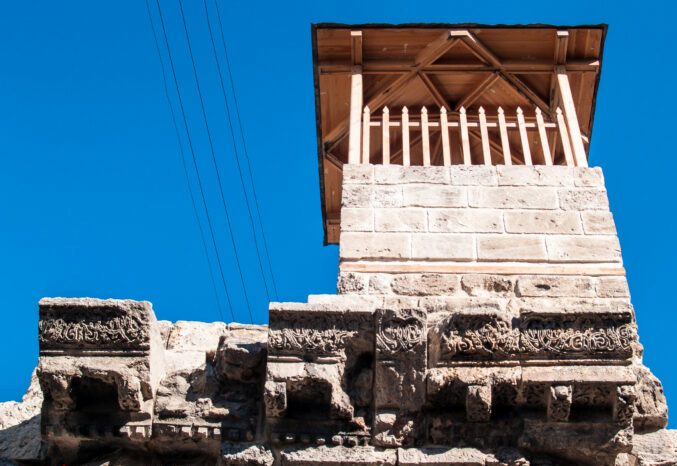


Al-Bahramiyeh Mosque (جامع البهرمية)
Built in the 16th century during the Ottoman period, Al-Bahramiyeh Mosque is a beautiful representation of classical Ottoman architecture in Syria. It was commissioned by Bahram Pasha, the Ottoman wali (governor) of Aleppo. The mosque features a single minaret, an elegant dome, and an interior that combines stone craftsmanship with subtle Ottoman decorative elements.
What distinguishes this mosque is its simplicity and balance—an aesthetic harmony that invites peaceful contemplation. The use of alternating black and white stone in the arches (ablaq style) adds rhythm and contrast to the façade. Located near the old bazaar, it has long served as a community hub for merchants and residents.
Al-Othamaniyeh Mosque (جامع العثمانية)
Constructed in 1730 by Othman Pasha al-Duraki, Al-Othamaniyeh Mosque is one of the finest examples of late Ottoman religious buildings in Aleppo. The mosque is part of a larger complex that includes a madrasa (Islamic school) and a sabil (public water fountain).
Its courtyard is paved with white stone and shaded by cypress trees, while the prayer hall features exquisite calligraphy and colored glass windows. The minaret rises elegantly, crowned with a pointed cap, reminiscent of Istanbul’s skyline.
Al-Othamaniyeh reflects a time when Aleppo was both a spiritual and commercial center of the Ottoman Empire, bridging Anatolia with the Arab world.
Al-Aadiliyeh Mosque (جامع العادلية)
Located in the heart of Aleppo’s ancient city, Al-Aadiliyeh Mosque was built in 1556 by the Ottoman governor Darwish Pasha and named after the Ottoman Sultan Suleiman’s daughter, Adila. It is known for its elegant dome, slender minaret, and peaceful courtyard.
The mosque’s architectural style mixes local Syrian craftsmanship with Turkish elements. It has a symmetrical layout, a tiled mihrab (prayer niche), and beautiful Arabic inscriptions adorning its walls. Historically, it functioned not just as a mosque but also as an educational and charitable center.
Al-Fardous Mosque (جامع الفردوس)
Aleppo Historical Mosques This remarkable mosque dates back to the Ayyubid period, built in 1236 during the rule of Malik al-Zahir Ghazi, son of Salah ad-Din (Saladin). Al-Fardous Mosque is known for its austere exterior but richly ornamented interior.
Inside, visitors will find pointed arches, calligraphic friezes, and a stone pulpit (minbar) with detailed carvings. Its historical significance stems from being a major center for religious learning in medieval Aleppo. The mosque stands as a testament to the city’s importance as a seat of Ayyubid rule and scholarship.
Al-Rumi Mosque (جامع الرومي)
Built in the 16th century by a figure known as Al-Rumi, this mosque is located near the Bab al-Nasr area. Though smaller in size, Al-Rumi Mosque is deeply cherished by locals for its spiritual atmosphere and unique Ottoman-style dome.
The interior is intimate and decorated with simple floral motifs and Qur’anic inscriptions. The mosque’s minaret is capped with a conical roof, and the courtyard, though modest, contains ancient stonework that speaks to Aleppo’s layered history.
Al-Atroush Mosque (جامع الأطروش)
Dating to the Mamluk era, the Al-Atroush Mosque was built in 1398 by Prince Aqbogha al-Turkumani, also known as Al-Atroush. It is located near the Citadel and is noted for its striking black-and-white ablaq stone façade.
Its muqarnas portal is one of the most sophisticated in the city, combining geometry and artistry to create an awe-inspiring entrance. Inside, the mosque features high domes and arched arcades. Al-Atroush was historically a center for Sufi practices, and its spiritual character remains strong today.
Al-Sultaniyeh Mosque (جامع السلطانية)
Situated near the Aleppo Citadel, Al-Sultaniyeh Mosque was established in the early 13th century during the Ayyubid dynasty. It is one of the earliest examples of integrated mosque-madrasa complexes in Aleppo.
Its main entrance is marked by elaborate stone carvings, and its prayer hall is known for its harmonious proportions and ornamental plasterwork. The complex also contains tombs of scholars and local rulers, making it both a religious and historical monument.
Al-Qiqan Mosque (جامع القيقان)
Though lesser-known among tourists, Al-Qiqan Mosque is one of Aleppo’s most charming neighborhood mosques. It was built during the Ottoman era and showcases the modest but graceful architectural style of the time.
Its square minaret and small courtyard evoke the image of Aleppo’s traditional community mosques—intimate, accessible, and deeply tied to local life. Despite its simplicity, Al-Qiqan continues to serve as a place of worship and social cohesion for its surrounding area.
Al-Tuashi Mosque (جامع الطواشي)
Aleppo Historical Mosques Built in the early 18th century, Al-Tuashi Mosque is a fine example of Ottoman provincial architecture. Located near the Suq al-Qadi, it features a tiled dome, pointed arches, and a square-shaped prayer hall.
The mosque’s name derives from its founder, Hajj Tuashi, a wealthy merchant. It reflects the era’s tradition of endowing public religious buildings as acts of charity and social responsibility.
Al-Shayabiyeh Mosque (جامع الشعيبية)
One of Aleppo’s oldest mosques, Al-Shayabiyeh Mosque is believed to date back to the Umayyad period, though it was later rebuilt and modified by the Ayyubids and Ottomans. It stands near the Citadel and was once associated with the famous scholar Shayab ibn Adnan.
The mosque’s modest size belies its great age and importance. Its early Islamic layout and architectural simplicity are rare survivors from a period that saw the spread of Islam across the Levant.
Al-Safahiyeh Mosque (جامع السفاحية)
Al-Safahiyeh Mosque is another Aleppo Historical Mosques, originally established in the Mamluk period. It is located near the Khan al-Wazir and features a central dome and a distinctive minaret that reflects Mamluk design elements.
The mosque is named after the Safa family, a prominent household that once owned the surrounding land. It played a key role in the religious life of Aleppo’s traders and artisans.
Experiencing the Mosques Today
Despite the damages caused by conflict, many of Aleppo Historical Mosques are undergoing active restoration, led by local artisans, religious authorities, and international cultural organizations. Visiting Aleppo Historical Mosques offers a profound spiritual and educational experience, especially when accompanied by a knowledgeable guide who can share their deep historical context.
Walking through the Old City, one is struck by the echo of adhan rising from slender minarets, the scent of incense mixing with old stone, and the sight of worshippers kneeling in quiet devotion—centuries blending into the present. Exploring Aleppo Historical Mosques allows visitors to witness architectural masterpieces and the resilience of a community determined to preserve its heritage. Each of the Aleppo Historical Mosques tells its own story of faith, artistry, and history, making a visit truly unforgettable. By the end of your journey, the memories of Aleppo Historical Mosques will remain etched in your mind, capturing both the beauty and the spirit of Syria
Finally.. If you have any questions, please contact us. To explore further, visit our Facebook Syria collection for rare images and cultural highlights.
Sources & References:
UNESCO – World Heritage Centre: https://whc.unesco.org
Archnet – Architecture & Heritage Database: https://www.archnet.org
World History Encyclopedia: https://www.worldhistory.org
Syrian Heritage Archive Project: https://syrian-heritage.org
Global Encyclopedia: Wikipedia



